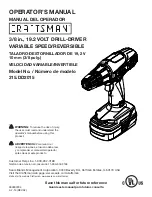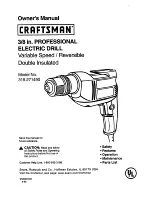
13
en
Batteries must not be disassembled, opened or reduced in
size. Do not subject batteries to mechanical impact or
shock.
Hazardous vapours and fluid can escape in case of
damage and improper use of the battery. The vapours
can irritate the respiratory system. Liquid ejected from
the battery may cause skin irritations or burns.
When battery fluid from a damaged battery has come into
contact with objects close by, check the respective compo-
nents, clean them or replace them as required.
Keep the battery away from heat and fire. Do not store the
battery in direct sunlight.
Do not remove the battery from its original packaging until
it is going to be used.
Before any work on the machine itself, remove the battery
from the power tool.
If the power tool accidentally starts,
there is danger of injury.
Remove the battery only when the power tool is switched off.
Keep the battery away from children.
Keep the battery clean and protect it against moisture and
water.
Clean contaminated battery terminals and power
tool connections with a dry, clean cloth.
Use only intact original FEIN batteries that are intended for
your power tool.
When working with and charging incor-
rect, damaged, repaired or reconditioned batteries, imi-
tations or other brands, there is danger of fire and/or
explosion.
Follow the safety warnings in the operating instructions of
the battery charger.
Hand/arm vibrations
The vibration emission level given in this information
sheet has been measured in accordance with a standard-
ised test given in EN 60745 and may be used to compare
one tool with another. It may be used for a preliminary
assessment of exposure.
The declared vibration emission level represents the
main applications of the tool. However if the tool is used
for different applications, with different accessories or
poorly maintained, the vibration emission may differ.
This may significantly increase the exposure level over
the total working period.
An estimation of the level of exposure to vibration
should also take into account the times when the tool is
switched off or when it is running but not actually doing
the job. This may significantly reduce the exposure level
over the total working period.
Identify additional safety measures to protect the opera-
tor from the effects of vibration such as: maintain the tool
and the accessories, keep the hands warm, organisation
of work patterns.
At a glance.
The following numbering of the product fea-
tures refers to the illustrations at the beginning
of this Instruction Manual.
1 Quick-action chuck
For mounting the tools and clamping them.
2 Torque setting ring with drilling level/impact drilling
level (ASB14, ASB18)
For setting the torque.
Select the operation mode, “drilling” or “impact
drilling”.
3 Gear level switch for slow or fast speed
(ABS12, ABS14, ABS18, ASB14, ASB18)
For setting the speed.
4 Auxiliary handle with depth stop (ABS18, ASB18)
Hold the power tool with both hands.
For setting the drilling/driving depth, work using the
depth stop.
5 Rotation selector switch for clockwise/anti-clockwise
rotation
For selecting the direction of rotation.
6 Switch
For switching the power tool ON and OFF.
7 Battery
Remove the battery from the power tool and charge
using the battery charger.
8 Unlocking button
Press the button and remove the battery from the
power tool.
9 Standard accessories
Carrying case (9a),
2 batteries (9b),
Battery capacity (9c),
Bit (cross-slot Pozi size 2 and 3) (9d),
Bit (Philips size 2 and slot size 6) (9e).
Operating instructions.
Charging the battery.
Prior to the first charging procedure, read the
operating instructions of the battery charger.
Charge the battery fully before putting into opera-
tion for the first time.
➤
Remove the battery (7) by pressing the unlock-
ing button (8) and pulling the battery out of the
handle towards the front. Do not exert any force.
➤
Plug the battery charger into the socket, push
the battery onto the battery charger and charge the
battery. Once the battery has been charged, mount
the battery onto the power tool and pull the plug
of the battery charger out of the socket.
A new battery does not reach its full capacity until after
several charging/discharging cycles.
If a battery is already charged, do not charge it
again.
Do not charge the battery until it is has become dis-
charged and is therefore no longer able to carry out any
more screwdriving.
If the battery becomes discharged within a short time
despite being charged correctly, it has reached the end of
its service life.
If the power tool is not going to be used for a longer
period, pull out the battery. In this way, harmful, low bat-
tery discharging is avoided.
Mounting the auxiliary handle (Figure 4).
➤
Open the clamping ring by turning the auxiliary
handle (4) anti-clockwise.
➤
Position the additional handle (4) on the spindle
collar and turn to the required angle.
➤
Close the clamping ring by turning the auxiliary
handle (4) clockwise.
3 41 01 031 06 1.book Seite 13 Dienstag, 10. Mai 2011 4:52 16














































